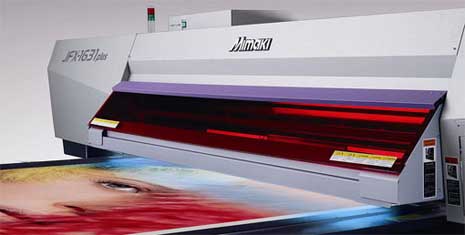
The development of affordable LED technology for UV-curable printing systems has continued apace for more than a decade, with few manufacturers now denying its benefits over mercury vapour lamps. With more and more customers demanding more environmentally friendly output together with lower prices, any investment in the printroom this year should be with LEDs in mind.
Just the somewhat Victorian words 'mercury vapour' may be enough to put off eco-conscious print customers when the clean-sounding 'LED' is available elsewhere. But the numbers stack up too: thanks to LEDs' ability to direct energy more efficiently into curing rather than heat, the overall power consumption is significantly less than that used by mercury lamps.
Comparing its own systems, EFI VUTEk states that switching to LEDs could reduce a wide-format printer's energy use by 75 per cent – the LED technology used in the VUTEk GS3250LX gets through around 3.6kW per hour, while the VUTEk GS3200's four mercury vapour lamps consume around 15kW per hour, or 9,000 kilowatt hours of energy each year for LED versus 46,800 for mercury vapour for those businesses running a two-shift, five day week - with an average cost of £0.15 per kilowatt hour at UK standard rate, that is an annual saving of nearly £6000 in electricity alone. Comparing the exposure system of metal halide lamps (mercury vapour lamps with added metal halogens), Mimaki estimates that MH can use as much as 15 times more than its standard UV-LED curing unit.
Moreover, Mimaki – creators of the first LED UV printer, the UJV-160 and maker of UV-LED systems including the JFX-1631 and UJF-3042 – also points out that LEDs offer lower energy consumption due to their instant-access approach; MH lamps must cool down before they can be switched on then heat up again before use, and therefore tend to be left on semi-permanently, while UV-LEDs can be turned off between jobs and reactivated almost instantly when needed. This level of 50 per cent use equates to consumption of more than 30 times as much energy by the MV system compared to UV-LED.
Among the chief benefits of the latest breed of UV-LED printers promoted by their manufacturers is versatility. Belgium-based digital print business Triakon adopted UV-LED curing in the form of an EFI VUTEk GS3250LX and found heat-sensitive and thinner materials were suitable for printing without head strikes or buckling with the 'cool cure' technology. Fellow VUTEk user BCF Digitaldruck und Mediengestaltung of Remscheid, Germany found that hard PVC of thicknesses as low as 0.2 to 0.5mm were now printable, while fewer stable panels like hard foam PVC panels were subject to shrinking or expanding due to heat exposure. The latter company also claims to achieve good results with laminated corrugated board, due in part to losing the need for a strong vacuum; a lower heat means the printheads can be lowered onto the substrate.
Using thinner, and therefore more lightweight, materials also reduces costs – EFI VUTEk user PVS In-Store Graphics reports savings its customers 30 per cent on the lower cost of materials plus an additional 30 per cent on shipping, as the business can roll up its work rather than transporting it in flat boxes. EFI adds that recycled materials can be used more readily too, again appealing to environmentally conscious consumers, while Mimaki highlights the business advantages in adding more unusual substrates to printers' portfolios, such as wood, plastic and 3D objects.
LEDs also last longer than mercury vapour lamps, to the tune of a 20,000-hour lifetime compared to under 2,000 hours, meaning less downtime and lower costs. BCF Digitaldruck und Mediengestaltung reports changing the mercury lamps on its previous VUTEk GS3200 up to five times a year at a cost of $4,000.

Triakon are one of a number of EFI VUTEk users who are realising significant commercial and financial gains from the switch to LED UV curing. Read ourTriakon case study here.
Time savings also apply when wait-time for prints to dry following mercury vapour curing is eliminated; LED-cured work is touch-dry on completion as well as insoluble, meaning it can be rolled up straight off the bed to save space, or can be printed on again – for instance in layers for tactile printing.
Whilst UV printing is not without its disadvantages - operators can suffer skin conditions such as dermatitis if in direct contact with UV ink before it is cured, and UV light can cause damage to eyes - manufacturers have eliminated dangerous ozone and volatile organic compounds (VOCs) and therefore the necessity for major ventilation, which is perhaps another perfectly viable reason to consider the upgrade to current and safer LED UV print technology.
In all, the benefits of LED curing compared to mercury vapour or metal halide lamp technology are too numerous to ignore. Healthier and simpler to use for operators, with cost savings and environmental pluses that can be passed on to the customer, the equipment currently on the market is definitely worth investigating.
Further reading...
1. LED curing and high productivity makes VUTEk GS3250LX the 'obvious choice' for Triakon
2. Mimaki White Paper - Why UV-LEDs are revolutionising ink jet printing




